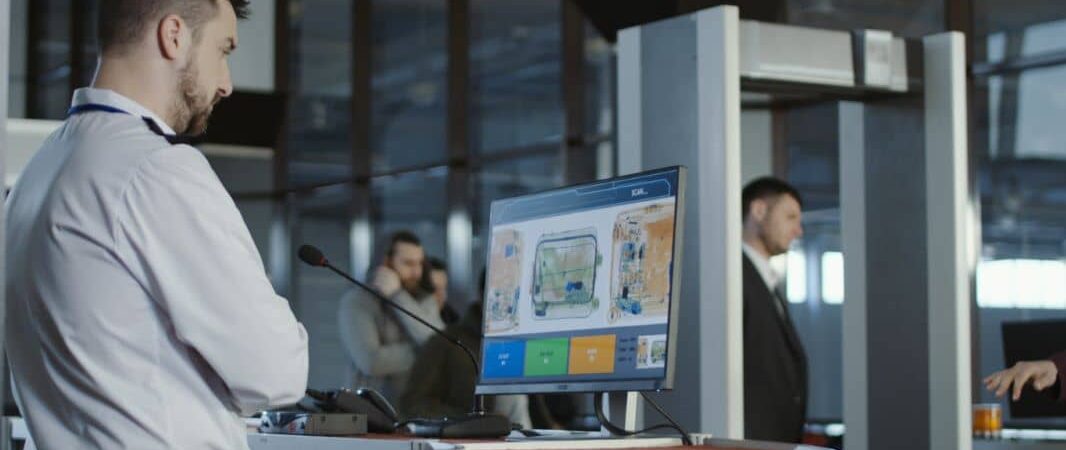
Airports are unique travel hubs that welcome 1000s of people each day from around the globe, which can pose a significant threat to passengers and airport staff.
There is a real threat to life if dangerous people and weaponry gain access onboard flights and those who wish to harm enter restricted areas in our airports.
Fortunately, new technology is emerging that allows for a more robust security presence with the help of artificial intelligence. AI is used far and wide in business and public venues to enhance security and allow for a safer experience for those in attendance.
You may not even notice it is operating around you, which is the point: providing robust protection without barriers.
Do you know about the latest in AI and how AI will improve airport security? Let’s check out what is being implemented now.
AI Threat Detection
To move people around airports effectively, you need frictionless access points to enter terminals and gates.
Metal detectors and pat downs create jams and produce long lines, so airports are integrating better AI solutions to detect potential threats while being inconspicuous.
Gateway screening allows for the flow of traffic as they are scanned for weapons like:
- Knives
- Guns
- IED components
This quickly and effectively detects and alerts security staff to threats before someone gains access on board, and the situation is handled before the perpetrator even knows what is happening.
This technology also works with video surveillance and access controls to create robust threat detection and response to keep people safe. Unfortunately, we live in a dangerous world, so AI threat detection is vital to keeping people safe while travelling.
This is how AI improves airport security. AI is being developed and harnessed to aid in our lives, and there is a need for enhanced protection at our travel hubs.
Those companies at the forefront of AI innovation are to be applauded for their efforts and systems adopted to protect travellers as they venture around the globe and enjoy their experience in a safe and secure environment.
Situational Awareness
Airports are huge compounds that include vast parking areas, perimeter grounds, multiple terminals, many exits and entrances, and a network of tunnels and pathways below the public areas.
These are all viewed by 100s of cameras that need to be monitored for potential threats, but the manpower is overwhelming.
With AI, all of this real-time footage is screened and monitored to look for critical events and emerging threats as they happen. It can perceive, understand, and effectively respond to several scenarios and alert security staff to any emergencies as they unfold.
Slip and Fall Protection
Part of making an airport secure is keeping passengers safe from injury. With the massive crowds that travel through airports, hazards always present themselves. These include:
- Poorly maintained floors
- Liquid spills
- Turned up carpets
- Rushing passengers
Using security and video analytics, any slips and falls are immediately detected, and staff can be alerted to repair or clean them up before they produce worse problems.
First aid staff can also attend to any injuries faster, and this helps to prevent any other passengers and staff from getting hurt.
Access Control
When there is a threat at an airport or an emergency event, you need to be able to lock down areas to restrict access from those who may want to harm.
AI can effectively protect the airport perimeter and access points along with restricted and airside passageways when there is a threat and effectively lock down specific areas to safeguard visitors and workers.
Facial recognition is also a more comprehensive way to allow for the flow of people, including:
- Passengers
- Visitors
- Company employees
- Vendors
- Service providers
Instead of using swipe cards that can be lost or stolen, AI incorporates facial recognition and biometrics to restrict and gain access to different areas inside an airport.
If there is an unauthorized entry, real-time alerts can be sent to security staff so they can respond quickly to any critical situations that pose a danger.
Biometric Boarding
Having air stewards check boarding passes and verify identities slows the airport onboarding process. With 1000s of travellers moving through the terminals, AI is being implemented to speed up the process and enhance security.
Using facial biometric technology, AI can authenticate those looking to board planes so the identity of passengers is more accurate, and there is little chance of deception.
At the biometric checkpoint, a passenger’s face is scanned and compared to their passport that was previously scanned early to ensure a match.
Some airports are doing away with boarding passes altogether as they can rely on pre-registered biometrics, automated touchpoints, and scanners to identify people as they look to gain access to aircraft.


